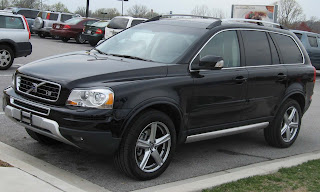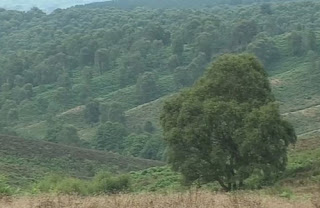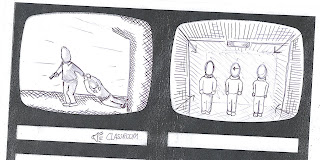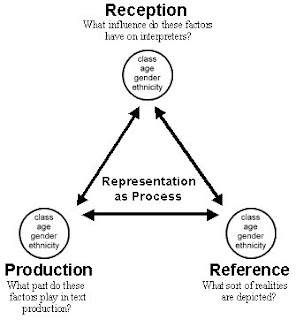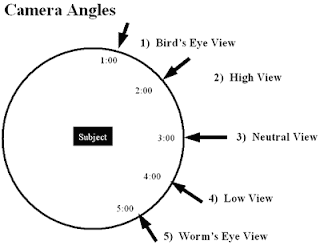My overall thoughts on our piece were very positive, I thought we tried really hard to create suspense and tension and what we put in, we got out.
In what ways does your media product use, develop or challenge forms and conventions of real media products?Our thriller was filmed after we studied many professional thriller films. Studying these films helped us realise the forms and conventions of thrillers and allowed us to interpret them into our own.
Watching ‘American Gangster’ and ‘The Departed’, personally influenced me to plan ours. It helped me decide how to put across certain messages to the audience and taught me not to make things to obvious.
From the start we used establishing shots to settle the audience down as many good thrillers do, letting them get to grips with there whereabouts of the scene. We wanted to make sure that we gave no indication to the location or time of day; we wanted them to try and work it out for themselves. This is done in many thrillers, we wanted the readers to think about what they are seeing so that they started to think in one direction and then as they are convinced they know what is happening we mislead them.
As the car drives over the top of the camera we cut inside it, we wanted to make sure we didn’t give the audience a clear view of who is in the car so we used low key lighting and used a darkening effect.
The following shot is another one of the vast landscape and then suddenly the same car appears over the brow of the hill, with the slow paced music we made this shot send out a message. That this car is not stopping for anything and as it speeds past the camera it makes the audience ask questions about where the car may be going, who’s inside it, why are they driving so fast?
After another shot of inside of the car, its cuts to it pulling up outside a run down building, the shots of this run down area create an uneasy atmosphere. All the films that we have studied do what we have done; they settle the audience and that start to make them feel uneasy about things.
The next shot is the first clear indication to what is happening as a man drags a young boy out from the car and pulls him toward the entrance of the building. In this clip we didn’t want to use any effects, we wanted the audience too see exactly what is happening.
I studied the opening of ‘The Usual Suspects’, in that opening they never give a clear view of what is going on. Apart form the car scene, in our piece we did the same by using low key lighting, and then using industrial lamps to create shadows, this makes the audience have to really look to see what’s happening.
It then cuts to the tiled room, like all good thrillers they use the protagonist reactions to first give any indication to what is about to be shown. We used Tom’s expression to make the audience think of what he could be looking at and then we cut away to it. A man tied up to a chair with a bag over his head. As it cuts away there is a thud, which was purposely put in to create a little jump.
As the two men and the boy walk towards the victim, we cut back and forth between the two shots to remind the audience what they are seeing.
A lot of the time world class directors use a lot of slow motion to capture emotion, so that is what we did, we had a reaction shot of Tom, reacting to the victim tied up. This also made the audience feel sympathy for the young boy Tom. Which was a key thing to achieve as in all thrillers, you need to have a protagonist who everybody can relate to.
The final scenes we have a tense build up, with any climax in thrillers, they don’t bring the penultimate moment in for a while, so that the audience is on the edge of there seats. With ours we tried to do the same, but I felt we didn’t hold the build up for long enough, we had cutaways shots between the victim and the young boy who is about to shoot him. And then finally pulls the trigger, but like in all good thriller openings, it cuts away before you see whether the gun shot hit him.
The soundtrack we used throughout reflected what we wanted the audience to feel, it pace was just right for the movements although a different track could have been used for the scenes in the building.
How does your media product represent particular social groups?Our media piece particular focuses on organised crime run by gangs of white middle aged men. We were influenced by Irish American mob gangs like the ones in ‘The Departed’. The way they go about doing things was our main inspiration, how they are so calm, but brutal. We particularly presented these men to be from a very poor background and to be uneducated, but have learnt the tricks of the trade through former gang members or perhaps family members. Our gang is presented to be quite close. They seem very calm around each other and well organised. I believe that the Irish are considered to be quite a passionate group in today’s society and there are not many like them. Our representation of middle aged men and how they dress was an important one to consider for us. With all of us having fathers we looked to see how they would dress on any normal day and found them to be a good model to base our costumes around. We found that they commonly wore lighter coloured jeans; they rarely are seen to be wearing hoodies as that is seen to be allocated with a younger age. It was more along the lines of puffer jackets or leather jackets. We took all of this into consideration when portraying these groups, so that we could do it in the correct way.
What kind of media institution might distribute your media product and why?Researching into the different distribution companies and looking specifically at the ones that distributed ‘American Gangster’ and ‘The Departed’ helped us see who might distribute ours. And with our piece running along the same lines as these two films which were distributed by ‘Universal pictures’ and ‘Warner Bros’ we thought that either of these would be ideal for distributing our film. As they are both known to distribute films that run along the criteria of Thrillers and have films that are certificated at 15 which is what our piece was given.
Who would be the audience for your media product?Our audience would be for all of those thriller lovers, who enjoy all the conventions of thriller films. I think that anyone below that certificated age of 15 would not be suitable as it would contain scenes that would not be appropriate for them to see. I think mainly our target audience would be middle aged people. I think that would be the age group that would appreciate the work efforts that we put in, but also they would appreciate the portrayal of gangs and young children. I think particularly they would find the portrayal of Irish American gangs to be interesting.
Also the fact that the film contains a lot of effects and fast shots it would suit this age group, any age group higher would perhaps find it all to much.
How did you attract/address your audience?We attracted the audience by making sure that our film looked professional, films are anticipated now days to be at such a high quality standard that anything that looks the slightest out of shape, people turn a blind eye to it. I believe it was important to follow the typical thriller techniques, so that we would lure the audience in and settle them down and then begin to give twists or quicken the pace of the film etc. Aspects like this really help to draw the audience in, I think it was also vital to have a good storyline, people sometimes can see how the story is going to go just from the opening, it was important that we did not give any indication to what will happen further on in the film.
I believe that the main way we addressed people was by the common use of allowing the audience to connect with the protagonist. It was important that all our representation of social groups were correct and precise to help them understand the thinking behind these groups.
What have you learnt about technologies from the process of constructing this product?Before our continuity piece a had no experience with editing, especially on Apple Mac’s. But through the continuity I learnt a great deal, which aided me when editing our main piece. I found that editing our main piece was the exercise that taught me the most.
I found that you have to ensure that when filming shots you give enough time at the start and the end of each shot to give you enough film to edit, so that you weren’t cutting off any of it and if you wanted a particular effect you had enough time to apply it etc.
I learnt that lighting played an extremely key role in making our film look professional; it is very easy to not notice the change in light between each shot, so you have to make sure that you check the lighting for every shot, so that it flows nicely. With ours we found it difficult and at some points there was too much change in the light when filming in two separate rooms. But after a while spent testing the contrasting effect on the Mac we resolved the problem.
The most vital aspect of all with the technology used was the audio; it was unquestionable that this had to be spot on, because looking at other AS Media films it was always the audio that let them down. It was either not flowing or the quality of sound was poor and because of this you weren’t able to hear the key things they wanted you to hear. With ours I found it was important to consider sound in every shot, I made sure when filming that we were all completely silent even if we were not going to use the sound from the camera, because then I would still have a choice when it came to edit it all. We also found with the audio hat it was easier to record sound separately and then add it in. The only doubt I had about our piece was the lack of diagetic noise.
Looking back at your preliminary task, what do you feel you have learnt in the progression from it to the full product?I have learnt that organization is key, it is important that we were organized throughout filming, like such things as remembering equipment or props and ensuring that everybody knew the meeting times etc.
Another vital aspect was the planning; I found it reassuring that when we came to film we had a plan. Without the plans we made and storyboards we would have been stuck for ideas a lot more often, but as we had planned, the filming flowed at a good pace.
I feel from the preliminary task to the final product I have learnt a great deal, mainly the best way I have learnt this is through my mistakes which have then amended. I feel a lot more confident when editing, I feel if I were to film again that I would be more prepared and would give myself more time between shots, so that editing became easier. And I generally feel that this experience has made me appreciate the work effort that goes into not only the major movie productions, but the smaller productions like my own.




